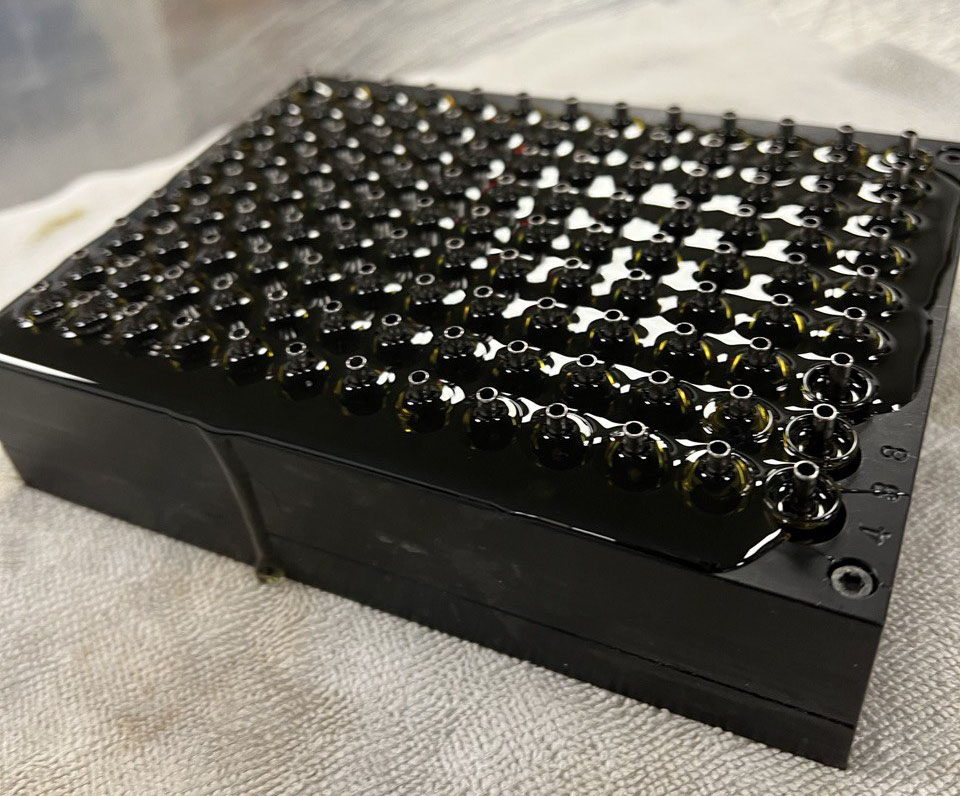How to Prevent Leaks in Vape Cartridges
This comprehensive vape manufacturing guide explores the primary causes of vape cartridge leaks, including filling technique errors, extract formulation issues, and user behavior, while providing detailed mitigation strategies to help lab directors improve product reliability and customer satisfaction.
by Jeff Wu - January 22, 2022
Leaking vaporizer cartridges are a significant issue in the industry, with various stakeholders pointing fingers at different culprits. Is it the oil, the terpenes, substandard hardware, filling techniques, or simply users leaving their cartridges in a hot car? This discussion aims to deconstruct the major aspects of carts leaking so that lab directors can reduce chargebacks and increase customer satisfaction.
When I first started investing in the regulated products space in 2015, one of the first people I met presented me with a cartridge and explained that this piece of plastic and metal was one of the biggest problems in the industry. Fast forward more than half a decade, and after multiple investments into extraction, vape manufacturing, and distribution to some of the largest vape companies in the USA, I have aggregated a list of items that impact vaporizer leakages.
What Causes Cart Leaks
Loss of vacuum lock is the primary cause of vaporizer cartridge leaks. Regardless of the reason, whether it is due to something, someone, or some event, the vacuum lock must have been released. Modern cartridges are designed based on the vacuum lock principle, and lab directors can often prevent cart leaks by optimizing the manufacturing process and modifying formulations. When the cartridge initially draws fluid into the vaporizer, a small vacuum forms at the top of the reservoir. This vacuum “holds” the extracts in the oil chamber, while the outside pressure pushes against the extracts, keeping them inside. The three main areas that cause cart leaks (vacuum loss) are:
1. Filling Technique Errors: Long cap times, defective capping, slanted capping.
2. Extract Formulation: Excess terpene and dilutant loads, live resin mixtures, rosin degassing.
3. User Behavior: Flying with cartridges, leaving them in hot cars.
Manufacturing Errors
1 Not Capping Fast Enough:
Issue: Slow capping results in no vacuum lock forming or a weak vacuum lock taking effect. The time required to form a vacuum lock depends on the temperature (both extract and cartridge) and the viscosity of the extract being filled. The general rule is to cap within 30 seconds. Fast capping ensures that a vacuum lock can form when the cartridge is capped. Until the cap is installed, the extracts are exposed to the atmosphere, and if not capped quickly, all the extracts will flow out of the cartridge. This effect is noticeable in filling machines that fill cartridges but do not cap, where the first cartridges filled start to leak as the last few are being filled.
Mitigation Procedures:
Secure the cap as fast as possible. If this is not feasible, consider the following:
-Use more potent extracts (90% potency with 5-6% terpenes) to increase viscosity, thereby extending the time needed to cap.
-Lower filling temperatures to 45°C to extend the time needed to cap. This will not work for very dilute solutions where most cartridges require capping within 5 seconds.
-Use automation equipment like the Xylem-2 that can fill and cap within 3 seconds, eliminating this issue.
2 Defective Capping / Capping Technique:
Issue: The capping technique is often overlooked when evaluating cart leakage rates. Miss capping usually involves:
Pressing the cap down at an angle.
Mis-threading that deforms the inside of the cartridge, preventing proper sealing.
Here is an example of angled clamping: when the cap is forced down at an angle, the cartridge looks undamaged from the outside, but the center post alignment and inside seals are damaged, compromising the sealing capability. Duckbill and cartridges with irregular caps have the highest probability of mis-caps. Mis-threads occur when threads do not fit together correctly, causing the seals to be warped when locked together, leading to vacuum loss.
Mitigation Procedures:
For manual labor lines, use a large-format arbor press (1+ ton-force). These presses are easier to operate and have a large pulley. Contrary to public perception, greater downforce allows smoother action by the assembly personnel, leading to fewer defective caps.
Choose caps like barrel and bullet designs that are easy to cap in all situations. Easy-to-cap mouthpieces simplify the capping process for all processes and personnel.
Automation eliminates capping issues entirely.

Extract Formulations
How They Impact Cart Leaks
Overuse of Dilutants, Cutting Agents, and Excess Terpenes: Extract purity and final formulations greatly impact the leakage rate. Vaporizers for highly viscous extracts like D9 and D8 are designed for such materials, and the addition of dilutants above normal terpene loads negatively impacts the core and absorbent cellulose. Dilutants like PG or MCT oil weaken the extracted matrix, leading to bubbles forming at the core that can travel to the main oil reservoir and break the vacuum seal.
Live Resin – Excess Terpene Layer Usage and Improper Degassing: Many people have reported live resin leakages in the past. The main culprit (assuming the hardware and filling technique is correct) is the excess use of the terpene layer from a crystallized live resin. Typically, the live resin needs to be mixed with distillate in a 50/50 distillate-to-live resin ratio to form a final mixture. The terpene layer itself (an extremely desirable product) is not viscous enough to be held inside a cartridge. In their desire to create a more premium product, formulation scientists often overuse the terpene layer, leading to excess terpenes that weaken the vacuum lock of the cartridge. Other more serious issues include excess residual butane being released when the vaporizer starts to get warm from use. Excess butane needs to be removed during extraction at a laboratory facility.
Rosin – Improper Light Aromatic Degassing: Similar to live resin, rosin needs to be degassed and crystallized before formulation with distillate. The issue with rosin is the presence of light aromatics; these light aromatics (some completely flavorless) will evaporate and cause pressure during cartridge activation, causing the cartridge to break the vacuum lock and leak. Proper degassing is critical to ensure that stable rosin is usable for vaporizer cartridges.
Mitigation Procedures:
Dilutants, Cutting Agents, and Excess Terpenes:
-Use high-quality distillate in the 90% range or higher to preserve viscosity.
-Limit total terpene addition to 5%-8% across all flavors to keep dilutants low.
Live Resin:
-Use a 50%/50% to 60%/40% distillate-to-live resin ratio (terp layer mix). Any higher terp percentage risks cart leaks; any lower than 40% risks flavor dilution.
-Ensure proper residual butane evaporation in a near vacuum at 45°C.
Rosin:
-Properly degas light aromatic terpenes at 45°C. These light aromatics (although mostly flavorless) can be cold-trapped and recollected for dabble products if desired.
User Behavior
Any time you leave something in a heated area, you’re very likely to have physical reactions occur.
Every time users fly with cartridges, the low pressure of a plane weakens the vacuum lock. Whether it’s due to simple pressure changes or complex chemical reactions that denature the terpenes causing off-gassing, users put a lot of stress on cartridges. Formulators can offset some, but not all, of the events users put their products through.
Cartridges in a Hot Car:
Issue: Hot temperatures averaging around 120°F (45°C) cause vacuum locks to fail.
Mitigation Techniques:
Standard Distillate Cartridges: Use a formulation with 90% purity distillate and a 5-6% terpene load, as these are the most survivable under hot conditions.
Live Resin: Assuming users will still want to use a live resin cartridge after exposure to heat (live resin will denature after 3 hours at 45°C), a 60% distillate, 40% live resin cartridge will be more resistant to leaks. If temperatures rise above 45°C, there is a high chance of cart leaks due to terpene off-gassing.
Rosin: Assuming users will still want to use a live rosin cartridge after exposure to heat (rosins are even more sensitive due to inherent plant waxes and will denature after 3 hours at 45°C), a 60% distillate, 40% rosin cartridge will be more resistant to cart leaks. If temperatures rise above 45°C, there is a high chance of leaks due to terpene gassing.
Airplane Rides:
Issue: Reduced atmospheric pressure causes the vacuum lock in the cartridge to fail.
Mitigation Strategies:
a. Pressure-Resistant Packaging: This integrally sealed packaging prevents pressure changes from affecting the cartridge. This is one of the best solutions for transport, whether for air travel or distribution trucks driving up mountains.
b. Formulation Adjustments:
Standard Distillate Cartridges: Use a formulation with 90% purity distillate and a 5-6% terpene load, as these are the most survivable under pressure changes.
Live Resin: Use a 60% distillate, 40% live resin cartridge to be more resistant to pressure-induced leaks.
Rosin: Use a 60% distillate, 40% rosin cartridge to be more resistant to pressure-induced cart leaks.

Jeff Wu
Technical Director
Investor & entrepreneur, bringing a unique blend of scientific knowledge and hands-on experience in pharma, laboratory, manufacturing, and cannabis. Deep understanding of chemistry, electronics manufacturing, automation, and cannabis processing.